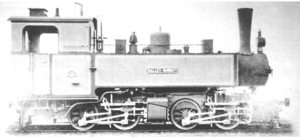Hohenzollern type lm
| Hohenzollern type lm | |
|---|---|
|
historical recording
|
|
| Numbering: |
Geilenkirchener Kreisbahn 1 lm and 2 lm BTr 6 lm |
| Number: | 2 |
| Manufacturer: |
Hohenzollern serial numbers 1191 and 1192 |
| Year of construction (s): | 1899 |
| Retirement: | until 1952 |
| Type : | B'B n4vt |
| Genre : | K 44.7 |
| Gauge : | 1000 mm ( meter gauge ) |
| Length over buffers: | 8,040 mm |
| Length: | 7,140 mm |
| Height: | 3,540 mm |
| Width: | 2,400 mm |
| Total wheelbase: | 4,000 mm |
| Empty mass: | 19 t |
| Service mass: | 27 t |
| Wheel set mass : | 6.75 t |
| Top speed: | 30 km / h |
| Control type : | Heusinger |
| Number of cylinders: | 4th |
| HD cylinder diameter: | 250 mm |
| LP cylinder diameter: | 380 mm |
| Piston stroke: | 400 mm |
| Grate area: | 0.85 m² |
| Evaporation heating surface: | 45.5 m² |
| Water supply: | 3 m³ |
| Fuel supply: | 0.8 t |
| Brake: | Indirect brake after conversion |
| Coupling type: | Balance lever coupling |
The Hohenzollern type lm of the West German Railway Company (WeEG) were meter-gauge, four - axle Mallet compound locomotives . From 1899 onwards, they operated on various lines of society. At times they were based on the small railway Bremen – Tarmstedt . The locomotives counted as so-called light Mallet locomotives of the WeEG and were in use until 1952.
history
After the first Mallet locomotives were delivered to the Albtalbahn by the mechanical engineering company Karlsruhe in 1897 , from 1899 onwards the WeEG procured two Mallet locomotives that could pull a train weight of 557 t on flat stretches.
The WeEG initially gave the locomotives the designation 1 m and 2 m , where m meant the mallet type . Since stronger locomotives with slightly different dimensions were procured from 1900 , the designation of the locomotives was changed to 1 lm and 2 lm , analogous to a light mallet .
The WeEG used the locomotives on various routes for over 50 years. For the WeEG , the Horrem railway office is initially specified as the place of use . The locomotives were also brought into connection with the Härtsfeldbahn .
Over the years, the locomotives have been moved from line to line more often. The Euskirchener Kreisbahnen , the Geilenkirchener Kreisbahn , the Kleinbahn Bremen – Tarmstedt and the Engelskirchen-Marienheider Railway are given as locations.
Both locomotives were in use at different times on the Bremen – Tarmstedt railway. From the 1930s they received a turbo generator for electrical lighting. Originally, the Görlitz weight brake was used to brake, later the indirect brake was introduced. From the Second World War , the locomotives had welded water tanks.
construction
The two rear axles were firmly mounted in the frame with the high-pressure engine, which was designed as an inner frame. The two front axles with the low-pressure engine were stored in a bogie, which was connected to the main frame by a pivot pin, in the inner frame. The boiler was supported by sliding plates on the bogie.
The locomotives had a compact design with a small wheelbase, a long funnel and a small boiler diameter. The control was carried out with flat slides , whereby the valve boxes were inclined. The locomotives had two cuboid sandboxes that were controlled manually from the driver's cab. Later the locomotives were equipped with a line for steam heating .
When used on the Geilenkirchener Kreisbahn, the locomotives were fitted with two strong chains on the heater side, with which standard-gauge wagons could be pulled onto the trestle system.
literature
- Henning Wall: The Geilenkirchener Kreisbahnen . Schweers and Wall, Aachen 2000, ISBN 3-89494-123-5 , pp. 98-101 .
Web links
Individual evidence
- ^ A b c d Henning Wall: The Geilenkirchener Kreisbahnen . Schweers and Wall, Aachen 2000, ISBN 3-89494-123-5 , pp. 98-101 .
- ↑ Data sheet of Kleinbahn Bremen – Tarmstedt with mention of the light mallets
